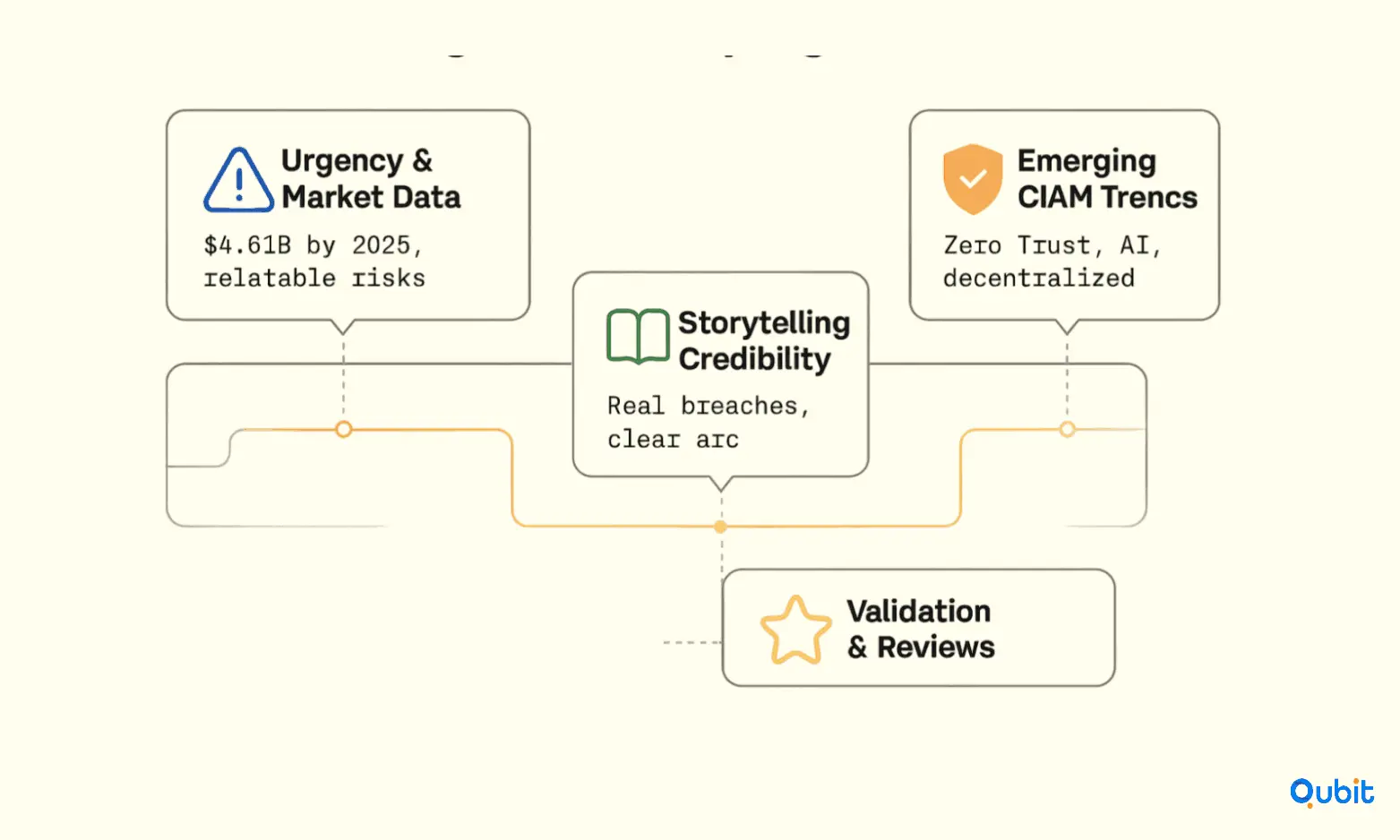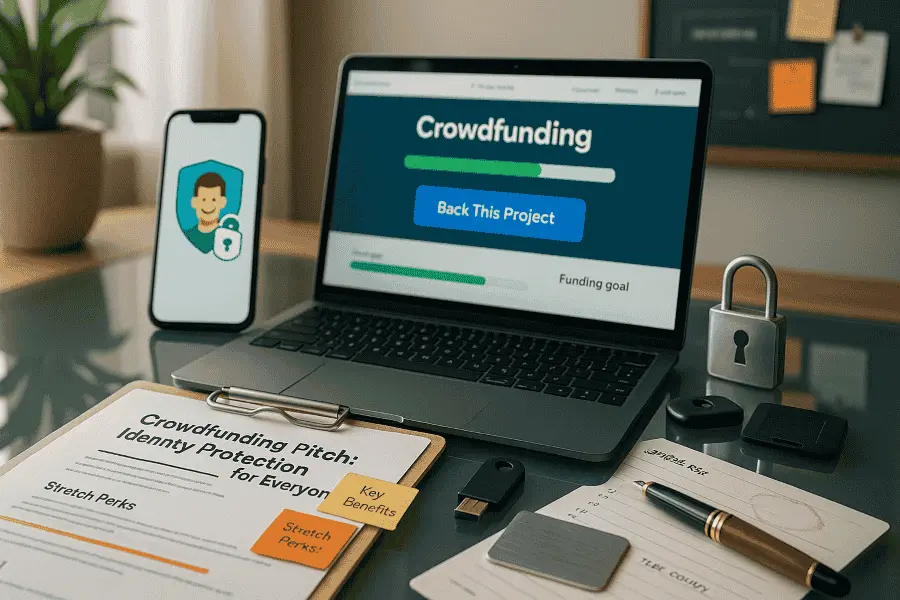Crowdfunding for identity protection startups has emerged as a strategic way for early-stage cybersecurity founders to build market traction, validate concepts, and raise capital without relying solely on traditional seed investors.
This guide will walk founders through crucial aspects, from selecting the right crowdfunding platform to post-campaign strategies, ensuring your consumer identity-protection solutions achieve maximum funding impact.
Choosing the Right Crowdfunding Platform for Identity Protection Startups
Selecting the appropriate crowdfunding platform is crucial to campaign success, as each caters differently to consumer backers or investor communities.
Rewards-based vs. Equity Crowdfunding: Key Differences
Founders must understand key distinctions between rewards-based platforms (Kickstarter, Indiegogo) and equity crowdfunding portals (WeFunder, StartEngine). Rewards-based platforms excel in consumer engagement and product validation through tangible rewards, whereas equity platforms appeal to investors seeking ownership.
Kickstarter, for instance, prioritizes community engagement and product storytelling, ideal for consumer-facing identity protection products. Equity crowdfunding attracts investors looking at long-term financial returns, often better suited to identity startups targeting enterprise solutions.
Platform Success Rates and Funding Dynamics
Understanding platform-specific success rates informs realistic campaign expectations. For instance, Kickstarter maintains a 42.36% success rate, though this dips to 24.28% in technology. Equity platforms offer higher potential funding limits but typically have rigorous compliance hurdles, influencing success probabilities differently.
Fees, Regulatory Caps, and Intermediary Requirements
All crowdfunding platforms charge fees—usually between 5–8%, plus payment processing costs. Additionally, equity crowdfunding Reg CF limits fundraising to $5 million annually, mandating SEC-registered intermediaries and disclosure filings. Regulation A+ extends fundraising up to $75 million but involves more stringent regulations.
Understanding these crowdfunding intermediary requirements ensures that your identity protection startup plans accordingly, avoiding regulatory roadblocks.
Matching Platform Audiences to Identity Protection Products
Selecting platforms with demographics aligned to identity protection solutions is key. Utilize built-in analytics tools such as Kickstarter’s Insights to determine audience fit, increasing chances of campaign resonance and success.
Further insights into optimizing your crowdfunding choice can be found in our detailed cybersecurity fundraising guide.
Crafting Your Campaign Narrative

Framing the Urgency: Identity Theft Data and Trends
A compelling narrative is the backbone of any crowdfunding consumer identity-protection solutions campaign. Emphasize the urgency by citing the rising risks of identity theft, the market is projected to reach $4.61 billion in 2025, growing at a double-digit CAGR. Translate technical jargon into relatable stories, helping backers understand both the scale of the problem and your unique solution.
Storytelling Elements That Build Trust and Credibility
Trust is built through transparency and relatability. Use real-world breach examples, such as the Equifax incident, to illustrate the stakes and make the threat tangible. Structure your campaign with a clear problem–solution arc, guiding backers from pain points to your innovative answer. This approach is a proven identity protection storytelling technique that resonates with both consumers and investors.
Incorporating Emerging CIAM Trends and Innovations
Position your offering as a leader in the evolving CIAM landscape by highlighting trends like Zero Trust security, AI-driven identity monitoring, and decentralized identity. Showcasing these innovations not only underscores your market relevance but also appeals to early adopters and tech-savvy backers.
Using Expert Endorsements and Testimonials
Endorsements from security experts or industry analysts can provide crucial third-party validation. Feature early reviews or press snippets to reinforce your credibility and differentiate your campaign from less substantiated competitors.
Crowdfunding Trends for Identity Protection Startups
Designing Reward Tiers and Backer Incentives for Identity Protection Campaigns
Optimal Price Points and Tier Numbering
Effective reward tiers crowdfunding identity protection campaigns start with strategic pricing. Set tiers at psychological thresholds—$20, $50, $100, $250—and offer limited early-bird specials to create urgency. This approach aligns price with backer willingness to pay and can drive early momentum.
Balancing Digital vs. Physical Rewards
Digital rewards such as premium access, security reports, or early software features are ideal for lower tiers, reducing fulfillment complexity. Higher tiers might include branded hardware tokens or exclusive physical merchandise, but consider print-on-demand fulfillment to minimize inventory risk.
Incentives for Repeat Pledges and Referrals
Sustaining campaign energy requires creative backer incentives identity security. Introduce referral bonuses or add-on rewards for repeat pledges, and deploy stretch goals to re-engage your community as you hit key milestones.
Costing, Fulfillment Timelines, and Logistics
Careful planning around fulfillment logistics is non-negotiable. Calculate shipping, taxes, and production costs with a buffer of 4–8 weeks, especially for international backers. Anticipate customs and regulatory hurdles to avoid delays and protect your reputation. For more on strategic investment, see our corporate vc iam investments.
Engaging & Growing Your Backer Community
Pre-Launch Audience Building and Lead Magnets
The foundation of backer community engagement crowdfunding identity protection is built before launch. Create compelling email sign-up incentives and pre-launch landing pages to attract early adopters. Securing at least 20% of your funding goal pre-launch dramatically increases your odds of success—79% of Kickstarter projects that hit this threshold ultimately succeed.
Social Media and Influencer Partnerships
Partner with cybersecurity influencers and engage online communities relevant to CIAM. Paid social ads can amplify your reach, but authentic influencer partnerships often yield the highest engagement and credibility.
Maintaining Momentum with Campaign Updates
Regular, transparent updates—such as weekly progress reports, behind-the-scenes videos, and Q&A sessions—foster trust and encourage repeat pledges. Encourage user-generated content and testimonials to further humanize your campaign. For ongoing tips, check out our crowdfunding identity protection guide.
Deploying Stretch Goals and Milestone Celebrations
Strategic stretch goals at 50% and 80% funding levels can reinvigorate your community. Celebrate milestones with live events or time-limited rewards to maintain excitement and urgency throughout your campaign.
Legal & Compliance Considerations
SEC Regulations for Equity Crowdfunding (Reg CF & Reg A+)
Compliance is critical for crowdfunding compliance identity protection. Under Reg CF, startups can raise up to $5 million per year but must use SEC-registered intermediaries and adhere to disclosure and resale restrictions. Reg A+ allows for larger raises—up to $75 million—but involves more complex compliance and is best suited for later-stage ventures.
Data Privacy Obligations (GDPR, CCPA) for Backer Information
Privacy laws like GDPR and CCPA require clear privacy policies, opt-in consent, and secure storage of backer data. Minimizing personal data collection and providing transparent opt-out mechanisms are essential for GDPR CCPA crowdfunding compliance.
Product Liability and Indemnity Considerations
Mitigating risk means obtaining product liability insurance and including indemnity clauses in your reward terms. Use disclaimers for both digital and physical rewards to set clear expectations and limit exposure.
When to Engage Legal Counsel and Insurance Solutions
Engage crowdfunding-specialist legal counsel early, especially for cross-border campaigns. Consider fulfillment insurance and errors & omissions (E&O) coverage to safeguard against delivery failures and legal disputes. For more on regulatory strategy, see our seed funding passwordless authentication.
Mapping Your Post-Campaign Roadmap
Key Post-Campaign Performance Metrics to Monitor
A robust post-campaign crowdfunding roadmap begins with tracking visitor-to-backer conversion rates (ideally 20–30%), average pledge amounts, and community growth. Repeat pledge behavior and email list expansion are strong indicators of ongoing engagement.
Maintaining Backer Relationships for Product Launches
Timely reward fulfillment schedules and transparent product updates are vital for preserving trust. Use backer stories as case studies in future marketing, and keep your community informed to nurture long-term loyalty.
Converting Backers into Long-Term Customers and Advocates
Offer post-campaign discounts to early adopters, encouraging them to transition into paid subscribers. Referral programs can leverage your backer network for cost-effective user acquisition, fueling organic growth and backer advocacy.
Identifying Next Funding Milestones and Raising Series A
As you scale, frame your Series A ARR expectations—most SaaS startups target $1–2.5 million in ARR before seeking Series A, with rounds typically ranging from $2–5 million at $25–75 million pre-money valuations. Aligning your post-campaign metrics with these benchmarks will sharpen your pitch for future investors.
Conclusion
Successfully crowdfunding identity protection startups involves strategic platform selection, compelling storytelling, optimized reward structures, diligent compliance management, and effective post-campaign planning. By carefully aligning your campaign strategies with these insights, you position your startup not only to secure funding but also to build a sustainable community poised for growth.
Get specialized support from Qubit Capital’s fundraising assistance service to optimize your campaign and reach your funding goals.
Key Takeaways
- Platform choice directly influences crowdfunding outcomes.
- Compelling storytelling linked to market data builds credibility.
- Reward tiers must balance appeal with logistical practicality.
- Regulatory and compliance management safeguards your campaign.
- Strategic post-campaign planning sustains growth momentum.
Frequently asked Questions
Which crowdfunding platform is best for consumer identity-protection startups?
Rewards-based platforms like Kickstarter and Indiegogo excel at consumer engagement, whereas equity platforms such as WeFunder or StartEngine offer investment-based fundraising. Kickstarter has a 42.36% success rate, while equity platforms under Reg CF enable startups to raise up to $5 million annually.






